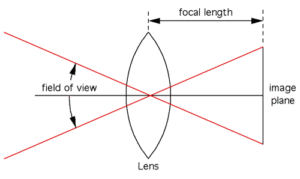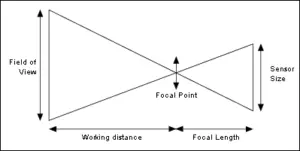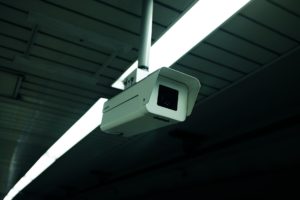More Tools for FOV Calculation:

Purchasing lenses will lead you to figure out differences between camera field of view and angle of view, how the field of view is calculated, and you will stumble upon further technicalities such as focal length and camera sensors. You have the choice to pick between different cameras with different crop sensors, as well as the option of purchasing full-frame cameras.
Lenses also come with a range of focal length and field of view, with the shorter focal length giving you a wider field of view and vice versa. But what do these terminologies really mean? And how can you calculate the field of view of a camera before getting your card out? Let me make it easier for you.
What is the Field of View?

In the simplest terms, the field of view is the visible field or the visible area that you can view through your camera right before you press the shutter.
It is measured in degrees and depends on the focal length of the lens and the sensors in the camera. Any field of the area that is outside the FOV of a camera is not captured. Hence, the field of view also refers to the horizontal, vertical, and diagonal dimensions processed by the camera.
To understand this concept better, let’s work through the focal length and digital multipliers or camera sensors. The focal length is the physical distance between the sensor and the optical center of the lens. It does not change as camera sensors or field of view changes. It’s a constant hence a 50mm focal length will remain 50mm whether it’s mounted on a full-frame camera or a 1.6x crop sensor camera.
Another factor that affects the camera FOV is the digital multiplier, which simply refers to the sensor size in digital cameras, which is smaller than the frame size of 35mm cameras. Another term commonly used for sensors is crop factor, with values such as 1,1.6x, and 2x alongside full-frame cameras.
Below, I have added a list of camera FOV that correspond to different equivalent focal lengths of the lens as per the crop factor of the camera sensor.
| Camera Field of View (diagonal) | Full-Frame (35mm) FL | APS-C (1.6x crop factor) Equivalent FL |
| 84° | 24mm | 15mm |
| 63° | 35mm | 22mm |
| 47° | 50mm | 31mm |
| 30° | 80mm | 50mm |
| 23° | 105mm | 66mm |
| 8° | 300mm | 188mm |
| 6° | 400mm | 250mm |
| 2.6° | 800mm | 520mm |
The Angle of View vs Field of View

In the layman context, angle of view and field of view are terms often used interchangeably. However, some experts argue that there are slight differences that set the two terms apart and are important to identify.
The angle of view is similar to the field of view in the sense that it is the angular degree of dimensions visible by the camera and it depends on the focal length of the lens plus the camera sensor. However, both properties are calculated through different formulas.
How To Use:
A simple mathematic way that you can calculate your camera’s field of view angles can be through the following steps.
- Research and find out the specifications of your lens and its camera.
- Using the FOV Calculator Camera tool above, input the values and select your camera.
- Click the “Calculate” button and it will tell you exactly the field of view.
You can also do this using a formula mentioned below:
The formula for angle of view is, where all measurements are in mm is:
Field angle of view = 2 x arctan ((sensor dimension eg: width/(2x focal length)) * (180/Π)
The formula for the field of view is:
Field of View = 2 (Tan (Angle of view/2) X linear distance to the object being captured)
- As per the equations, we can see that field of view also considers the distance between the lens and the subject being viewed through the camera.
- And thus, you are done! Calculating your camera field of view has never been easier than this.
Click on the lens angle of view chart below which will help you understand how the angular dimensions change as focal length and sensors change.
How to calculate the field of view (Manually without any Tool)?

The camera FOV calculation is majorly done whilst figuring out FOV for digital or CCTV cameras. The common measurements required include working distance, focal length, and sensor size.
To begin with, you would have to figure out your camera’s focal length multiplier. If you have a full-frame camera, the focal length mentioned on the lens specifications is the focal length of your field of view. However, if you have a camera with a smaller sensor, you would have to calculate the focal length multiplier or crop factor and find out the equivalent FL.
The normal full-frame (36mm) camera diagonal sensor dimensions are approx. 43.27mm. To find the crop factor of your camera, use the camera sensor dimensions and Pythagoras theorem to calculate diagonal dimensions. After this, divide the dimensions of a full-frame camera with that of your camera and round the figure off to find the crop factor.
You can also use a measuring tape to calculate the working distance between the subject in observation and the optical center of the lens. Next, simply plugin these values in the angle of view and linear field of equations mentioned above. Or, use an online camera field of view calculators such as this one to calculate FOV.
CCTV Camera FOV Calculators
 To calculate the CCTV camera field of view, follow similar steps and measure the distance from the subject in ft. Then, use CCTV camera calculator to find vertical and horizontal FOV. Additionally, to visualize how focal length changes your field of view, there are virtual stimulators available such as the DOF simulator which makes you input the specifications of your camera to develop lens field of view stimulation.
To calculate the CCTV camera field of view, follow similar steps and measure the distance from the subject in ft. Then, use CCTV camera calculator to find vertical and horizontal FOV. Additionally, to visualize how focal length changes your field of view, there are virtual stimulators available such as the DOF simulator which makes you input the specifications of your camera to develop lens field of view stimulation.
Camera FOV is one of the major factors that determines what you can capture through your camera. The lens angle of view chart helps determine which camera lens will be the most suitable for the type of photography you’re aiming to perform. Hence, calculating camera FOV prior to purchasing your lens can save you from regrets later.
Why Is This Tool Better Than Others?
Other research methods show that finding out the exact calculation and number, as compared to a camera to a telescope, is easier. With the help of math and a simple equation, one can now be able to simply find out the exact answer to their question and thus avoid hefty pays and fees to consult a professional or a clerk to find out your camera’s field of view.
Which is why we think this method is not only easier, it is quick, it revels its answers faster, and is able to generate the exact numbers of how much is your camera angle and field of view.